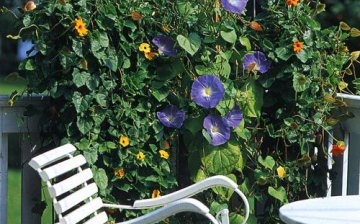Kobea creeping
Kobeya creeping refers to annual plants, but it happens that in regions with a predominantly warm climate, it can be attributed to perennials. The plant originates in a kind in Mexico. It has been widely used in the field of decorating gazebos, building facades, verandas, trellises and others. In the process of growth, Kobeya rises on a vertical surface without any support, or additionally artificial attachment.
The stem of the plant is branched, creeping, reaches an average of 2 m in height, but sometimes it can reach a height of up to 4 m. Kobei's flowers are large, up to 8 cm long, in the form of a bell. At first, the flowers have a light green color, but in the process of flowering, the color changes to purple, white, or lilac (depending on the species). Flowering begins in late June and usually ends in late autumn. If the climatic conditions are rather hot, then at the end of flowering fruits similar to oblong tomatoes may appear.
The plant is not whimsical and does not require excessive effort in the growing process. In a greenhouse or greenhouse, seeds are sown in March, and in open ground in the second half of April.
Before sowing, the seeds are best germinated initially in gauze soaked in a weak solution of potassium permanganate. Seedlings appear in 12-14 days. They dive and plant seedlings in May, when the ground is already warm enough and frosts are not planned, at a distance of 35-40 cm between each plant.
It is recommended to grow the plant in sunny, sheltered areas.
Category:Decorative



